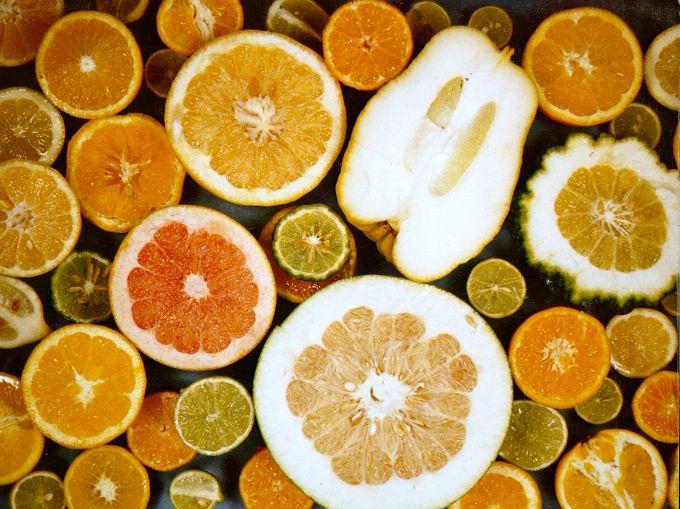Results & impact 10 October 2025
- Home
- Press area
- Press releases
- A new look at the evolution of Citrus
A new look at the evolution of Citrus

Work published recently in Nature revealed ten true Citrus species, four of which gave rise to modern cultivated varieties © P. Ollitrault, CIRAD
Following on from work by the International Citrus Genomics Consortium, which produced the Citrus reference genetic sequence in 2014, scientific teams from Spain, the USA and France (CIRAD and INRA) joined forces to analyse the evolution of the genus Citrus and related genera*. Based on complete genome data for 60 varieties and wild forms representative of the diversity of Citrus , the scientists came up with a new evolutionary model for the genus Citrus . The model calls into question the taxonomic systems developed for Citrus in the 1960s, which continues to account for the existence of three different botanical classifications for Citrus .
Two phases of spread cast doubt on the borders of the genus Citrus
The phylogenomics work done within this study revealed ten true species amongst the 60 varieties analysed. Those ten species are the result of some eight million years of evolution, during which scientists now recognize two major phases of evolutionary diversification: the first in Asia at the end of the Miocene period, between six and eight million years ago, and the second in Australia at the start of the Pliocene period, around four million years ago. The first phase may be linked to a dramatic reduction in monsoons in Asia at the time, and led to a separation into eight branches, including four ancestral species from which cultivated Citrus varieties originated. The second phase resulted in three Australian lime species.
The main modern Citrus groups trace their origins to four ancestral species
Four of those ten true species, C. reticulata, C. maxima, C. medica and C. micrantha , correspond to four modern Citrus groups , respectively: mandarins, pummelos, citrons and a papeda known as biasong in the southern Philippines, where it originated. Through natural interspecific hybridization, these four ancestral species subsequently resulted in most cultivated varieties, including oranges, grapefruits, lemons and limes.
Certain groups, such as sour oranges, rough lemons and Rangpur limes or Mexican limes are the result of direct hybridization between these four ancestral species, respectively: C. maxima x C. reticulata, C. reticulata x C. medica and C. micrantha x C. medica . Others, such as lemons, sweet oranges and grapefruits, resulted from more complex evolutions, involving interspecific recombination. "Lemon, for instance, is a hybrid between a sour orange and a citron; grapefruit a hybrid between a pummelo and a sweet orange", Franck Curk from INRA explains. "Sweet oranges, for their part, have a complex structure resulting from a mixture of two ancestral species, C. reticulata and C. maxima . Their exact origin is not yet clear", Patrick Ollitrault from CIRAD adds.
"Unlike modern citrons and pummelos, which appear to be pure representatives of the species C. medica and C. maxima, all cultivated mandarins have parts of their genome drawn from pummelos. This natural introgression may have played a major role in the domestication of mandarins, in particular by modifying the synthesis of certain acids, making their fruits more popular", Franck Curk points out.
Towards more innovative varietal breeding strategies
In addition to identifying the ancestral species that gave rise to cultivated Citrus varieties, the study served to pinpoint the origin, throughout the genome, of the different Citrus chromosome fragments. These complex structures largely govern the essential traits that determine the typicality of an orange, a grapefruit, a lemon or a lime. Whereas conventional breeding (through sexual crossing) of these cultivated varieties previously looked to be impossible, detailed knowledge of ancestral species and their structures paves the way for innovative breeding strategies. "This knowledge enables us to target the parents of future varieties more efficiently. When crossing, the aim is to rebuild these structures using the diversity of the ancestral species or of intermediate horticultural groups. This type of strategy is already being developed by CIRAD and INRA with a view to diversifying limes in Corsica and Guadeloupe" , Patrick Ollitrault reveals.
INRA and CIRAD have access to one of the four largest Citrus collections for their research. The Biological Resource Centre in question, at San Giuliano in Corsica, covers 14 ha and comprises more than 1100 cultivated varieties from some 50 countries. It is the world's most diverse mandarin collection, and is a valuable tool for research ranging from genomics to participatory breeding of new Citrus varieties with stakeholders in Mediterranean and tropical supply chains. Those new varieties must satisfy market demand and respond to the constraints faced by the supply chains, such as new diseases (for instance Huanglongbing) or pests, and increasing drought and soil salinization because of climate change. The research conducted has local, regional, national and global impacts, since Citrus production is one of the major fruit sectors worldwide, with 125 million tonnes produced each year on the five continents.
* On the initiative of the Instituto Valenciano de Investigaciones Agrarias (IVIA) in Spain
Partners in the study:
- Centro de Genómica, Instituto Valenciano de Investigaciones Agrarias, Spain
- US Department of Energy Joint Genome Institute, USA
- Computational Genomics Department, Centro de Investigación Príncipe Felipe (CIPF), Spain
- Genetic Improvement and Adaptation of Mediterranean and Tropical Plants Joint Research Unit (UMR AGAP), CIRAD, INRA, France
- Department of Botany and Plant Sciences, University of California, Riverside, USA
- Functional Genomics Node, Spanish National Bioinformatics Institute (ELIXIR-es) at CIPF, Spain
- Citrus Research and Education Center (CREC), Institute of Food and Agricultural Sciences (IFAS), University of Florida, Lake Alfred, USA
- University of California, Berkeley, Department of Molecular and Cell Biology and Center for Integrative Genomics, USA.



























